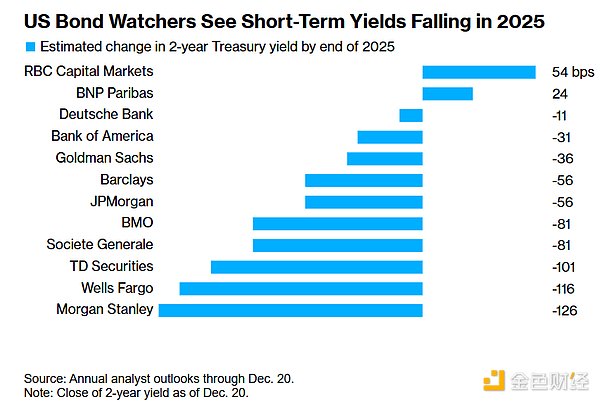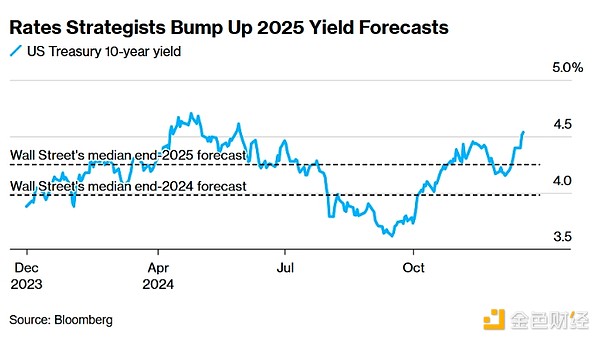Source: Jinshi Data
Despite the looming threat to the bond market from President-elect Trump's trade and tax policies, Wall Street is taking its cue from the Federal Reserve and predicting lower U.S. short-term Treasury yields in 2025.
Strategists are mostly in agreement on forecasts for a decline in the 2-year Treasury yield, which is more sensitive to the Fed's interest rate policy. They believe that 12 months from now, yields will fall by at least 50 basis points from current levels.
"While investors may be myopically focused on the pace and magnitude of rate cuts next year, investors should step back and recognize that the Fed is still in rate-cutting mode in 2025," said a team led by David Kelly at JPMorgan Asset Management in the firm's annual outlook.

U.S. bond watchers expect short-term bond yields to fall in 2025
However, the Fed indicated at its meeting this month that it would reduce the number of rate cuts next year, which could complicate the yield trend.
Currently, the median forecast of Fed officials shows a rate cut of only 50 basis points in 2025, which is roughly the same as Wall Street's forecast for the 2-year Treasury yield trend, but it also brings the risk that the Fed will pause its easing cycle. The yield curve steepened Thursday to its highest level since June 2022 as investors reconsidered the merits of holding longer-dated bonds after Fed Chairman Jerome Powell placed the blame for a possible pause in further rate cuts squarely on inflation.
"As the outlook for an easing cycle shallows, so will the front end of the curve," said Tracey Manzi, senior investment strategist at Raymond James. "Any steepening will be led by the long end of the curve."
The median forecast of 12 strategists is that the 2-year Treasury yield will fall about 50 basis points to 3.75% in a year. For the longer-dated 10-year Treasury note, strategists see the yield, which was about 4.52% on Friday, reaching 4.25% by the end of 2025, about 25 basis points below its current level.

"No matter how you analyze it, whether it's actual growth, inflation expectations or term premium, long-end bonds are going to be under pressure," said Noel Dixon, a macro strategist at State Street Securities, who has been predicting that the 10-year Treasury yield could rise above 5% in 2025.
They consider not only different views on how fiscal policy might evolve, but also the Fed's management of its Treasury holdings. The end of the Fed's balance sheet reduction, or quantitative tightening, could reduce bond supply, which in turn stimulates demand.
Even if the Fed is likely to continue to cut policy rates, pulling down front-end yields, many of the factors that suggest long-term yields will continue to move higher remain: a high neutral rate, heightened rate volatility, an inflation risk premium, and large net issuance on price-sensitive demand," a Barclays team led by Anshul Pradhan wrote in a report.
Bloomberg Intelligence strategists Ira F. Jersey and Will Hoffman believe that "a steady-state economy in early 2025 may lead the Fed to cut rates slowly, potentially capping it at 4%. A major shift in the economy may be needed before the 10-year Treasury yield is stuck in a range of 3.8% to 4.7%."
In addition, Trump’s tariff and tax policies will unfold in the coming weeks, which could upend Wall Street’s outlook.
"Higher tariffs and tighter immigration controls suggest slower growth but higher inflation," Pradhan said.
Currently, Morgan Stanley and Deutsche Bank hold the most bullish and most bearish views on the bond market, respectively. Morgan Stanley sees "downside risks to growth" and an "unexpected bull run" for investors. The firm expects the Fed to cut rates faster than other banks, so it expects the 10-year Treasury yield to fall to 3.55% in December next year.
Deutsche Bank predicts that the Fed will not cut rates until 2025, and the team led by Matthew Raskin expects the 10-year Treasury yield to rise to 4.65% due to strong economic growth, low employment and high inflation.
"We expect the main catalyst for our view to be the realization that inflation and labor market conditions require a more stringent path from the Fed than is currently priced," they wrote in a note.
 Alex
Alex
 Alex
Alex Kikyo
Kikyo Alex
Alex Kikyo
Kikyo Alex
Alex Kikyo
Kikyo Alex
Alex Kikyo
Kikyo Brian
Brian Hui Xin
Hui Xin